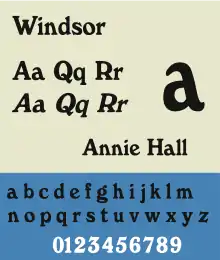Windsor (typeface)
Windsor is a serif typeface created by Eleisha Pechey (1831-1902) and released by the Stephenson Blake type foundry.[1] It is intended for use such as display and in headings rather than for body text.
 | |
| Category | Serif |
|---|---|
| Classification | Display |
| Designer(s) | Eleisha Pechey |
| Foundry | Stephenson Blake |
Capitals M and W are widely splayed, P and R have very large upper bowls. The lowercase a, h, m and n of the Windsor font have angled right hand stems, e has an angled cross-stroke. Bitstream in their release notes to its digitisation call it 'a creative variation on the old-style form'.[2]
Releases
Various foundries have released versions, including Linotype, Elsner+Flake, URW++ and Mecanorma. As many early digitisations were sublicensed, several of these may represent the same digitisation marketed by different rights-holders, possibly upgraded with modern features such as contextual ligature substitution. A range of weights have been created for it, such as condensed, outline and bold.[3]
An unrelated face, also called Windsor, was designed by Edwin W. Shaar for Intertype in 1960.
Miles Newlyn designed the New Spirit typeface, based on the Windsor typeface.[4]
In popular culture
- Beginning with 1977's Annie Hall, almost all the title sequences and credits of Woody Allen's films use sparse, white Windsor Light Condensed over a black background.[5] The same font was used in the Ebury Press 2007 edition (ISBN 0091920213) of his 2007 book Mere Anarchy.,[6] as well as his 2020 memoir Apropos of Nothing.
- Windsor Bold is used for the title and credits of the TV series All in the Family, 227, Who's the Boss?, and The Goldbergs.
- The Whole Earth Catalog, published between 1968 and 1972, used Windsor font on its cover.
- Max's Kansas City in New York City used lowercase Windsor Bold in its logo from 1965 to 1981. The 7th Street Entry at the First Avenue nightclub in Minneapolis, Minnesota has also used lowercase Windsor Bold in its logo since 1981.
- Windsor Bold is also the typeface used in the 1980s trading card series Garbage Pail Kids.[7]
- For a majority of its run, and following its expansion to an hour long in 1975, The Price Is Right flashed phrases during the intro that were in Windsor. Originally, the phrase "One Hour" was flashed in an unknown script font, but by mid-December 1975, it was switched to "Hour Power" in Windsor, and the font remained in use until the opening titles were abandoned in 2009. Some episodes, particularly specials, instead used Cooper Black beginning in the late 1990s; this was abandoned in the fall of 2007.
- A condensed version of Windsor is used on the letter strips in Parker Brothers' 1978 game Punch Line.[8]
- For Sesame Street, the Windsor font was used for the album cover "Let a Frown Be Your Umbrella" by Oscar the Grouch.
- The heavier weight variations of Windsor are occasionally used as the mini-heading or the alternative wordmark for the Hellboy series.[9][10]
See also
References
- "Eleisha Pechey". Linotype. Retrieved 10 January 2016.
- "Windsor". MyFonts. Bitstream. Retrieved 10 January 2016.
- "Windsor Elongated in a Stephenson Blake brochure". Daily Type Specimen. Retrieved 10 January 2016.
- "New Spirit". Miles Newlyn. Retrieved 23 December 2020.
- Woody Allen's typography: Is this fetish or brand identity? from kitblog.com
- Mere Anarchy (ISBN 0091920213) from WorldCat
- GPK Card Name Font
- Punch Line image gallery at BoardGameGeek
- Hellboy: The Beast of Vargu cover preview
- Hellboy Library Edition Vol. 5
External links
- Eleisha Pechey - Luc Devroye's page on Pechey.
- identifont - Sample and links to purchase